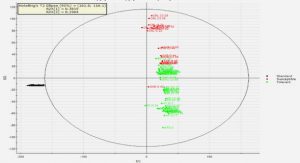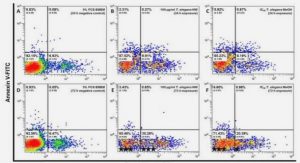Get Complete Project Material File(s) Now! »
Ceruloplasmin
The role of ceruloplasmin in syncytialization has not been studied, but its dysregulation may be implicated in the biology of preeclampsia (Aksoy et al. 2003; Serdar et al. 2006). Ceruloplasmin is the main plasma protein responsible for binding copper. This protein also has ferroxidase activity, oxidizing iron(II) to iron(III), an essential step before iron(III) is loaded onto transferrin (Healy and Tipton 2007). Ceruloplasmin therefore plays a key role in the regulation of iron homeostasis and has an antioxidant effect by helping to prevent lipid oxidation catalyzed by metal ions (Engin-Üstün et al. 2005). Expression of ceruloplasmin can be induced by inflammatory mediators and repressed through translational control when iron is deficient (Mazumder et al. 2006). Studies have found serum concentrations of ceruloplasmin increased (Griffin 1983; Vitoratos et al. 1999; Aksoy et al. 2003; Engin-Üstün et al. 2005; Serdar et al. 2006) or unchanged (Hubel et al. 1996) in preeclamptic women.
Phospholipid transfer protein
As its name suggests, phospholipid transfer protein (PLTP) transfers phospholipids between lipoproteins and cells. Transfer of phospholipids facilitates interconversion of chylomicrons and very low density lipoproteins (VLDL) into HDL, regulating plasma HDL levels (Setälä et al. 2007). PLTP also accelerates the removal of α-tocopherol (vitamin E) from atherogenic lipoproteins (Jiang et al. 2002). Dysfunctional vascular endothelium and lipid oxidation are key processes implicated in preeclampsia, and PLTP is involved in both processes: the vitamin E transported by PLTP can be 70 incorporated into the endothelial wall and may prevent the vessel dysfunction caused by oxidized LDL (Desrumaux et al. 1999). In the placenta, cell surface phospholipids are involved in the mechanism of syncytial fusion (Pötgens et al. 2002). The expression of PLTP observed here in FSKtreated BeWo cells may be involved in the STB-like fusion events known to occur in this culture system.
Proactivator polypeptide precursor
The proactivator polypeptide precursor, also called prosaposin, encodes four saposin or sphingolipid activator proteins found in lysosomes (Chataway et al. 1998). No studies have directly investigated the role of these proteins in the placenta or in preeclampsia. Both prosaposin and the saposins participate in the lysosomal degradation of sphingolipids (Vaccaro et al. 1999). As these lipid complexes are key components of the cellular plasma membrane’s lipid bilayer, it is possible that prosaposin is present in FSK-treated BeWo cells in conjunction with syncytial fusion. Fusion may incorporate controlled breakdown of the plasma membrane at cell-cell junctions. Further studies are necessary to uncover information about the participation of saposins in placental biology.
VE-cadherin
Vascular endothelial cadherin, like its epithelial counterpart E-cadherin, is a cell adhesion protein with documented changes in its expression patterns during pregnancy and in preeclampsia (Zhou et al. 1997b). During cytotrophoblast differentiation, the expression of VE-cadherin is almost inversely related to that of E-cadherin (Zhou et al. 1997a). E-cadherin expression reduces markedly in both cytotrophoblasts and BeWo cells during syncytialization (Coutifaris et al. 1991). Staining for Ecadherin has been used as a qualitative measure of trophoblast differentiation, with a loss of Ecadherin staining evident during cell fusion (Al-Nasiry et al. 2006). Downregulation of E-cadherin, and its inverse relationship with VE-cadherin, may explain the presence of VE-cadherin in the FSKtreated BeWo cells used in this study.
Depletion of albumin and IgG using a spin column
Serum was depleted of albumin and IgG using the Albumin and IgG Removal Kit (GE Healthcare) according to the manufacturer’s instructions. Unless otherwise noted, all steps were performed at room temperature. A 10× stock solution of Complete Mini EDTA-free protease inhibitor (Roche) was made by addition of one tablet to 1 mL H2O. Ten microliters of 10× protease inhibitor stock were added to 90 µL of thawed serum. Twenty microliters of serum containing protease inhibitor were added to 750 µL of antibody slurry and mixed for 30 min on a rotary shaker at 300 rpm. The serum-antibody mixture was added to a microspin column and centrifuged at 6500 ×g for 5 min.
TABLE OF CONTENTS :
- ABSTRACT
- ACKNOWLEDGEMENTS
- LIST OF FIGURES
- LIST OF TABLES
- LIST OF ABBREVIATIONS
- CHAPTER 1 INTRODUCTION
- 1.1 Biomarker discovery
- 1.2 Proteomics
- 1.2.1 Techniques
- 1.2.1.1 Two-dimensional SDS-polyacrylamide gel electrophoresis (2DE)
- 1.2.1.2 Difference gel electrophoresis
- 1.2.1.3 Gel-free proteomics using mass spectrometry
- 1.2.2 Statistical considerations for 2DE analysis
- 1.2.2.1 Power and sample size
- 1.2.2.2 Analysis of individual protein spots
- 1.2.2.3 Generation of multiprotein classifiers
- 1.2.3 Biological systems for proteomic studies
- 1.2.3.1 Plasma proteomics
- 1.3 Preeclampsia
- 1.3.1 Background
- 1.3.2 Risk factors
- 1.3.3 Pathophysiology
- 1.3.3.1 The placenta
- 1.3.3.2 Placental changes in preeclampsia
- 1.3.3.3 Placentally-derived factors in the etiology of the maternal syndrome
- 1.3.3.4 Maternal vascular and inflammatory responses
- 1.3.4 Biomarkers for preeclampsia
- 1.3.4.1 Diagnostic markers
- 1.3.4.2 Screening markers
- 1.3.5 Previous proteomic biomarker discovery for preeclampsia
- 1.4 Project aims
- CHAPTER 2 SERUM-FREE CULTURE OF BEWO CELLS
- 2.1 Introduction
- 2.2 Methods
- 2.2.1 2DE of cell culture media additives
- 2.2.2 BeWo maintenance culture
- 2.2.3 BeWo secretion and viability in serum-containing medium
- 2.2.4 BeWo secretion and viability in serum-free medium
- 2.2.5 Quantitation of hCG and LDH in conditioned media
- 2.2.6 Statistical analysis
- 2.3 Results
- 2.3.1 2DE determination of cell culture additive purity
- 2.3.2 Optimization of forskolin treatment regime
- 2.3.3 Secretion and cell viability in serum-free medium
- 2.3.4 Secretion time within serum-free media incubation
- 2.4 Discussion
- CHAPTER 3 SECRETED PROTEOMIC ANALYSIS OF BEWO DIFFERENTIATION
- 3.1 Introduction
- 3.2 Methods
- 3.2.1 Production of serum-free BeWo conditioned media for 2DE
- 3.2.2 Protein purification from culture media
- 3.2.3 Protein quantitation
- 3.2.4 2DE of BeWo conditioned media
- 3.2.5 Image analysis
- 3.2.6 Statistical analysis
- 3.2.7 Protein identification
- 3.3 Results
- 3.3.1 Preparation of conditioned media proteins for proteomic analysis
- 3.3.2 Optimization of rehydration solution components for BeWo media proteins
- 3.3.3 2DE analysis of secreted proteins from BeWo serum-free medium
- 3.3.4 Identification of protein spots
- 3.4 Discussion
- 3.4.1 α-1B-glycoprotein
- 3.4.2 Matrix metalloproteinase
- 3.4.3 Ceruloplasmin
- 3.4.4 Phospholipid transfer protein
- 3.4.5 Proactivator polypeptide precursor
- 3.4.6 VE-cadherin
- 3.4.7 Additional considerations
- 3.4.8 Conclusions
- CHAPTER 4 COMPARISON OF SERUM IMMUNODEPLETION METHODS FOR PROTEOMIC ANALYSIS
- 4.1 Introduction
- 4.2 Methods
- 4.2.1 Study population
- 4.2.2 Human serum specimens
- 4.2.3 Depletion of albumin and IgG using a spin column
- 4.2.4 Depletion of six proteins using the Multiple Affinity Removal System
- 4.2.4.1 Chromatography
- 4.2.4.2 Preparation of depleted serum for 2DE
- 4.2.5 2DE of depleted serum proteins
- 4.3 Results
- 4.3.1 Depletion of albumin and IgG using a spin column
- 4.3.2 Depletion of six proteins using a MARS column
- 4.4 Discussion
- CHAPTER 5 COMPARATIVE PROTEOMICS OF PREECLAMPTIC SERUM USING 2DE
- CHAPTER 6 COMPARATIVE PROTEOMICS OF PREECLAMPTIC PLASMA USING DIGE
- CHAPTER 7 SIGNIFICANCE AND FUTURE DIRECTIONS
GET THE COMPLETE PROJECT
PROTEOMIC BIOMARKER DISCOVERY FOR PREECLAMPSIA






